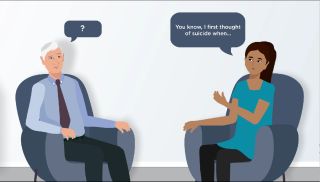Suicide
A Better Way to Understand and Assess Suicide Risk
Suicide is not a symptom of an illness but an action with a personal background.
Updated September 13, 2023 Reviewed by Tyler Woods
Key points
- The medical model misses the uniqueness of the suicidal individual.
- Psychiatric disorders are risk factors for suicide, not the cause of suicide.
- A suicide-as-as action model is a new paradigm for a person-centered understanding of suicidal behavior.
- Narrative interviewing is the first step to establish a therapeutic alliance with the suicidal patient.

People with suicidal ideation often do not seek help because they fear that health professionals will not understand them. They do not think they need medical treatment, and they are afraid of being admitted to a psychiatric hospital against their will. A therapeutic approach based on the model of suicide as an action is the way to establish a therapeutic alliance. A brief therapy program for people who attempt suicide can reduce the risk of reattempts by 80 percent.
What’s wrong with current suicide risk assessment?
Most medical professionals are alarmed when they suspect their patient may be suicidal. In medical training, they have learned that they are responsible for the safety of their patients, that it is their task to assess the suicide risk and decide on the management and safety of the patient. However, suicide risk assessment within the frame of the medical model doesn’t work because it misses the person in the patient. The typical medical professional understands suicide as a consequence of mental disorders and will ask questions about symptoms of depression, etc., while patients have their own personal psychological dynamic which led them to develop thoughts of suicide as a possible solution to an unbearable painful experience, often coupled with self-hate and self-rejection.
Medical professionals and suicidal patients speak different “suicide languages.” Because patients often feel that the physician will not understand their inner turmoil, they will not talk. They will keep their suicidal thoughts and plans to themselves. Most suicidal patients don’t think they need medical treatment. The typical medical consultation with the suicidal patient has been characterized as “dancing without touching.”
Risk factor models are used for suicide risk assessment. However, studies on the predictive value of suicide risk scales have yielded sobering results. Carter and colleagues [1] from a systematic review and meta-analysis of the predictive value of risk scales, concluded that “no instrument is sufficiently accurate as a basis to determine allocation to intervention”. Chan et al.,[2] in a review of risk factors and risk scales, concluded that the scales and tools reviewed had poor predictive value.
“The use of these scales or an over-reliance on the identification of risk factors in clinical practice, is, in our view, potentially dangerous and may provide false reassurance for clinicians and managers," the researchers write. "The idea of risk assessment as risk prediction is a fallacy and should be recognized as such.”
The medical model assumes a development from suicidal ideation to suicidal action, similar to a linear pathogenetic model in somatic medicine. However, suicide as a behavior does not fit into a linear illness model. Typically, suicidal risk waxes and wanes. Bryan and Rudd[3] argued that the “ideation-to-action framework” with suicidal thoughts as starting points and suicide attempts and suicide as endpoints has little to do with the clinical reality of suicidal individuals.
Suicidal people can explain their story to an attentive listener
In the '90s, my colleague Ladislav Valach, Ph.D., introduced me to the theory of goal-directed actions, or, in brief, action theory. Action theory represents how we communicate in everyday life, that is, we explain and understand actions—such as visiting a friend or going on holidays—with stories. We used this concept in assessment interviews with patients who had attempted suicide. We introduced our approach by simply asking patients to tell us the story behind their suicidal action.
As a psychiatrist, I was used to bombarding patients with a set of questions about signs and symptoms of mental disorders. Now, I had to learn that the roles were reversed: only the patients knew their personal story, while I was in the not-knowing position. And...it worked. Most patients gave me a coherent narrative of how they came to the point of harming themselves, what triggered it, and how it related to their life story. The term "narrative" [4] is defined as a story told to an attentive listener by giving meaning to events to explain the logic of a specific action. Suicidal patients generally have a good narrative competence—once they find themselves with an attentive listener who wants to find a joint understanding of the patient’s very personal suicidal development. This includes the emotional valence and the meaning of specific psychosocial stressors related to the person’s vulnerability, which is best understood in a biographical context (for instance, early trauma).
Telling the suicide story is therapeutic
Effective therapy needs a therapeutic relationship between patient and therapist. A narrative is the first time that patients put some structure into the story so that the listener can follow the chain of events and their meaning. A self-narrative is also the first therapeutic step in reflecting on the suicidal development. Most patients explain their suicide attempt in a biographical context. The therapist acts as a co-author of the patient’s story. Like this, we reach a shared understanding of the patient’s emotional crisis. Narrative interviewing is the opposite of a “one-size-fits-all” approach.
In a clinical study based on single interviews with those who have attempted suicide, we found [5] that patients’ ratings of the quality of the therapeutic relationship in the Penn Helping Alliance Questionnaire HAQ [6] were significantly better when, in the opening sentence of the interview, the interviewer used a narrative approach, that is, used the words “tell” (e.g. “can you please tell me how you came to the point of harming yourself?”) or “story” (e.g. “I would like to hear the story behind the suicidal crisis”). A second finding was that HAQ scores were higher when, in the interview transcripts, we found that interviewers acknowledged the importance of biographical issues related to suicidality (”You know, my fear of losing a close person goes right back to my childhood”).
The Aeschi Working Group, an international group of dedicated experts in clinical suicide prevention, published guidelines for clinicians [7] based on this approach. “The goal for the clinician must be to reach, together with the patient, a shared understanding of the patient's suicidality. This goal stands in contrast to a traditional medical approach where the clinician is in the role of the expert in identifying the causes of a pathological behaviour and making a diagnostic case formulation. It must be made clear, however, that in the working group's understanding, a psychiatric diagnosis is an integral part of the assessment interview and must adequately be taken into consideration in the planning of further management of the patient. The active exploration of the mental state, however, should not be placed first in the interview, but follow a narrative approach.”
Translating a new suicide model into a treatment program
Over the years, we further developed the narrative approach. My colleague suggested that we enhance the therapeutic effect by video-recording the narrative interview and, in the next session, collaboratively watching the video (“video-playback” or “self-confrontation” technique). We then asked ourselves how our experience with these tools could be translated into a brief therapy program. Because everywhere in the world, there is a lack of resources for psychotherapy, it seemed important to us to keep the therapy program as brief as possible. We added a few more elements and limited the therapy to three sessions. The result was the Attempted Suicide Short Intervention Program (ASSIP) [8], a brief, manualized therapy specifically for patients seen after a suicide attempt. These are individuals with an increased risk for further suicidal crises, including suicide. The treatment manual has so far been published in six languages. The results of the effectiveness study with 120 patients (60 ASSIP and 60 Control) revealed an 80 percent risk reduction for suicide reattempts over two years for ASSIP-treated patients [9].
The next post will focus on the theory and practice of ASSIP.
References
1. Carter, G., et al., Predicting suicidal behaviours using clinical instruments: systematic review and meta-analysis of positive predictive values for risk scales. Br J Psychiatry, 2017. 210(6): p. 387-395.
2. Chan, M.K., et al., Predicting suicide following self-harm: systematic review of risk factors and risk scales. Br J Psychiatry, 2016. 209(4): p. 277-283.
3. Bryan, C.J., & Rudd, M. D., The importance of temporal dynamics in the transition from suicidal thought to behavior. Clinical Psychology: Science and Practice, 2016(23(1)): p. 21-25.
4. Michel, K. and L. Valach, The Narrative Interview with the Suicidal Patient., in Building a Therapeutic Alliance with the Suicidal Patient., K. Michel and D.A. Jobes, Editors. 2011, American Psychological Association APA Books: Washington DC. p. 63-80.
5. Michel, K., et al., Therapist sensitivity towards emotional life-career issues and the working alliance with suicide attempters. Archives of Suicide Research, 2004. 8(3): p. 203-13.
6. Alexander, L.B. and L. Luborsky, The Penn Helping Alliance Scales, in The Psychotherapeutic Process: A Research Handbook, L.S. Greenberg and W.M. Pinsoff, Editors. 1986, Guilford Press: New York. p. 325–366.
7. Michel, K., et al., Discovering the truth in attempted suicide. American Journal of Psychotherapy, 2002. 56(3): p. 424-37.
8. assip.ch
9. Gysin-Maillart, A., et al., A Novel Brief Therapy for Patients Who Attempt Suicide: A 24-months Follow-Up Randomized Controlled Study of the Attempted Suicide Short Intervention Program (ASSIP). PLoS Med, 2016. 13(3): p. e1001968.




